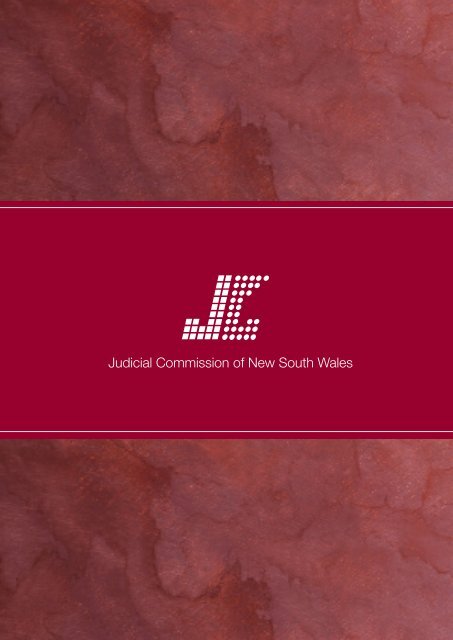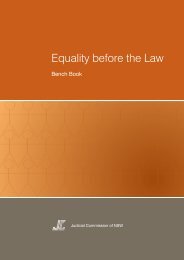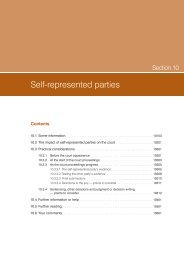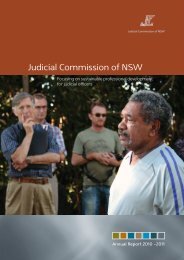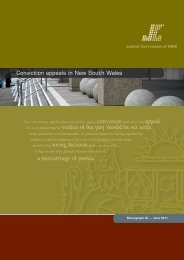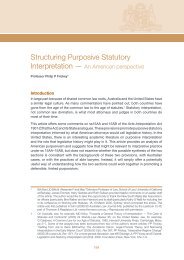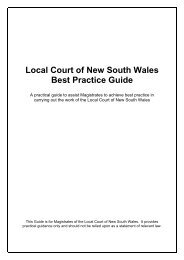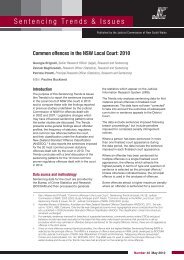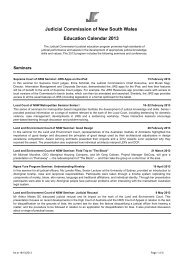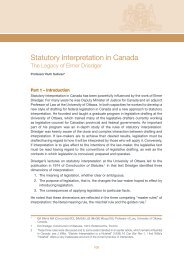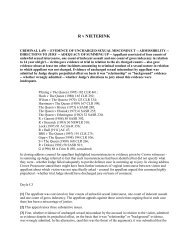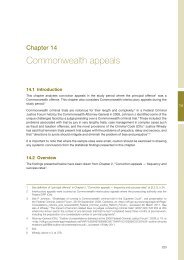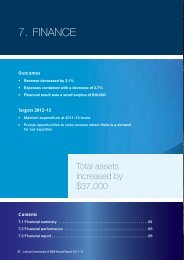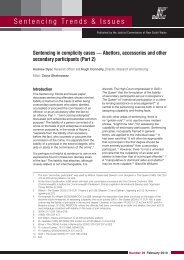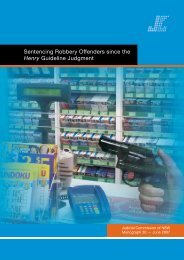From controversy to credibility: 20 years of the Judicial Commission ...
From controversy to credibility: 20 years of the Judicial Commission ...
From controversy to credibility: 20 years of the Judicial Commission ...
You also want an ePaper? Increase the reach of your titles
YUMPU automatically turns print PDFs into web optimized ePapers that Google loves.
<strong>Judicial</strong> <strong>Commission</strong> <strong>of</strong> New South Wales
<strong>Judicial</strong> <strong>Commission</strong> <strong>of</strong> New South Wales<br />
<strong>From</strong> <strong>controversy</strong> <strong>to</strong> <strong>credibility</strong>: <strong>20</strong> <strong>years</strong> <strong>of</strong> <strong>the</strong><br />
<strong>Judicial</strong> <strong>Commission</strong> <strong>of</strong> New South Wales 1<br />
A brief his<strong>to</strong>ry <strong>of</strong> <strong>the</strong> <strong>Commission</strong><br />
The <strong>Judicial</strong> <strong>Commission</strong> commenced operations<br />
in <strong>the</strong> old Chief Secretary’s Building on <strong>the</strong> corner <strong>of</strong><br />
Bridge and Macquarie Streets in Oc<strong>to</strong>ber 1987. 2 The<br />
government’s announcement in September 1986 that<br />
it intended <strong>to</strong> establish a judicial commission was<br />
highly controversial, generating heated exchanges<br />
in Parliament and between <strong>the</strong> Chief Justice <strong>of</strong> <strong>the</strong><br />
Supreme Court, Sir Laurence Street, and <strong>the</strong> At<strong>to</strong>rney<br />
General, Terry Sheahan. 3 Members <strong>of</strong> <strong>the</strong> judiciary<br />
and <strong>the</strong> legal pr<strong>of</strong>ession, watching from <strong>the</strong> sidelines,<br />
opposed <strong>the</strong> plan or wondered whe<strong>the</strong>r it could work. 4<br />
Twenty <strong>years</strong> on, <strong>the</strong> <strong>Commission</strong> remains <strong>the</strong> only body<br />
in Australia for <strong>the</strong> public <strong>to</strong> raise concerns about <strong>the</strong><br />
ability or behaviour <strong>of</strong> a judicial <strong>of</strong>ficer. 5<br />
<strong>Judicial</strong> independence from <strong>the</strong> executive government<br />
is a central value <strong>of</strong> <strong>the</strong> rule <strong>of</strong> law. 6 As Chief Justice<br />
Gleeson CJ put it: “[t]he duty <strong>of</strong> a judge is <strong>to</strong> administer<br />
justice according <strong>to</strong> <strong>the</strong> law, without fear or favour, and<br />
Chief Secretary’s Building<br />
without regard <strong>to</strong> <strong>the</strong> wishes or policy <strong>of</strong> <strong>the</strong> executive<br />
government.” 7 When Premier Unsworth charged At<strong>to</strong>rney General Sheahan in 1986 <strong>to</strong> “do<br />
something” about a perceived crisis in public confidence in <strong>the</strong> judiciary, 8 <strong>the</strong> Supreme Court<br />
judges initially saw <strong>the</strong> proposal as a direct attack on <strong>the</strong>ir independence and <strong>the</strong> separation <strong>of</strong><br />
powers in New South Wales. 9<br />
At<strong>to</strong>rney General Sheahan’s model for a judicial complaints mechanism emerged in <strong>the</strong> wake<br />
<strong>of</strong> public concern about <strong>the</strong> administration <strong>of</strong> justice generally. 10 Two prominent members <strong>of</strong><br />
<strong>the</strong> judiciary had been tried <strong>the</strong> preceding year with attempting <strong>to</strong> pervert <strong>the</strong> course <strong>of</strong> justice:<br />
High Court Justice Lionel Murphy and former Chief Magistrate Murray Farquhar. 11 Complaints<br />
<strong>of</strong> unjustified leniency in sentencing <strong>of</strong>fenders had been made against a District Court judge. 12<br />
1
The Honourable Sir Laurence Street AC, KCMG, QC<br />
was Chief Justice <strong>of</strong> New South Wales, 1974–1988<br />
and <strong>the</strong> first President <strong>of</strong> <strong>the</strong> <strong>Judicial</strong> <strong>Commission</strong>.<br />
Allegations <strong>of</strong> lengthy delays in delivering<br />
judgments, and inconsistent and lenient<br />
sentencing, are recorded in <strong>the</strong> Hansard and<br />
press reports <strong>of</strong> <strong>the</strong> day. 13 New South Wales<br />
had no judicial education body and <strong>the</strong>re was<br />
no single reposi<strong>to</strong>ry for sentencing statistics for<br />
State courts. 14 The Vinson report claimed that<br />
<strong>the</strong>re was systematic disparity in sentences<br />
imposed for drug <strong>of</strong>fenders. 15 On 23 September<br />
1986, <strong>the</strong> At<strong>to</strong>rney General announced <strong>to</strong><br />
Parliament that a judicial commission would<br />
be part <strong>of</strong> a package <strong>of</strong> reforms for <strong>the</strong><br />
New South Wales justice system, including<br />
<strong>the</strong> establishment <strong>of</strong> a direc<strong>to</strong>r <strong>of</strong> public<br />
prosecutions, an independent criminal court<br />
listing direc<strong>to</strong>rate and a courts division within<br />
<strong>the</strong> At<strong>to</strong>rney General’s Department. 16<br />
The plan for <strong>the</strong> judicial commission had been circulated <strong>to</strong> <strong>the</strong> heads <strong>of</strong> jurisdiction only<br />
two weeks prior <strong>to</strong> this announcement. 17 At<strong>to</strong>rney General Sheahan’s proposed model was<br />
based on <strong>the</strong> Californian <strong>Commission</strong> on <strong>Judicial</strong> Performance, 18 but in addition, <strong>the</strong> New<br />
South Wales body would combine a complaints function with facilities for judicial training and<br />
disseminating sentencing statistics. Sir Laurence Street describes <strong>the</strong> “instant and vigorous<br />
hostile reaction” from <strong>the</strong> Supreme Court judges 19 because <strong>the</strong> original plan meant that <strong>the</strong><br />
executive branch <strong>of</strong> government would have <strong>the</strong> power <strong>to</strong> discipline and remove judges found<br />
guilty <strong>of</strong> misconduct or unfit for <strong>of</strong>fice. <strong>20</strong> This was contrary <strong>to</strong> <strong>the</strong> method <strong>of</strong> removal for superior<br />
court judges which, since <strong>the</strong> Act <strong>of</strong> Settlement 1701, required an address <strong>of</strong> both Houses <strong>of</strong><br />
Parliament. 21 The At<strong>to</strong>rney General quickly capitulated <strong>to</strong> preserve Parliament’s constitutional<br />
role in <strong>the</strong> dismissal process and <strong>the</strong> <strong>Judicial</strong> Officers Bill was introduced in<strong>to</strong> Parliament on<br />
24 September 1986. 22<br />
Debate about <strong>the</strong> <strong>Judicial</strong> Officers Bill continued in an “immense blaze <strong>of</strong> publicity” in <strong>the</strong> media<br />
and in Parliament. 23 The Chief Justice, while agreeable <strong>to</strong> <strong>the</strong> need for judicial education and<br />
for sentencing information, saw that <strong>the</strong>se were cosmetic elements, a “sugarcoating” on <strong>the</strong><br />
plan’s real purpose — <strong>to</strong> make <strong>the</strong> <strong>Judicial</strong> <strong>Commission</strong> a branch <strong>of</strong> <strong>the</strong> At<strong>to</strong>rney General’s<br />
Department. 24 Sir Laurence Street issued a public statement, signed by 32 Supreme Court<br />
judges, condemning <strong>the</strong> “extraordinary haste” with which <strong>the</strong> Bill had been drafted and <strong>the</strong><br />
lack <strong>of</strong> consultation. 25 The <strong>controversy</strong> raged for a few “heady weeks”. 26 <strong>Judicial</strong> pressure<br />
on <strong>the</strong> government led <strong>to</strong> fur<strong>the</strong>r legislative amendments, 27 ultimately resulting in <strong>the</strong> <strong>Judicial</strong><br />
<strong>Commission</strong> becoming fully independent <strong>of</strong> <strong>the</strong> executive government.<br />
When <strong>the</strong> <strong>Commission</strong> finally commenced operating as an independent statu<strong>to</strong>ry corporation,<br />
it had its own budget, was financed directly by Parliament, would report annually <strong>to</strong> Parliament,<br />
and directly employed its own staff. The membership <strong>of</strong> <strong>the</strong> <strong>Commission</strong>, as proposed in <strong>the</strong><br />
original Bill, was <strong>the</strong> six heads <strong>of</strong> jurisdiction and two (now four) lay members appointed by <strong>the</strong><br />
Governor as nominated by <strong>the</strong> Minister. 28 The Act provided that sentencing information 29 and<br />
judicial educational services 30 would be established.<br />
Reflecting on <strong>the</strong> “most public and deep battle” he fought, Sir Laurence Street regards <strong>the</strong><br />
establishment <strong>of</strong> <strong>the</strong> <strong>Commission</strong> as “a huge vic<strong>to</strong>ry for <strong>the</strong> judiciary” and “a bastion <strong>of</strong> <strong>the</strong><br />
independence <strong>of</strong> <strong>the</strong> courts”. 31 Former At<strong>to</strong>rney General Sheahan is also “immensely proud”<br />
<strong>of</strong> his role in forming <strong>the</strong> <strong>Commission</strong>, commenting that it was “<strong>the</strong> best thing for judges, although<br />
<strong>the</strong>y didn’t realise it at <strong>the</strong> time”. 32<br />
2
<strong>From</strong> <strong>controversy</strong> <strong>to</strong> <strong>credibility</strong>: <strong>20</strong> <strong>years</strong> <strong>of</strong> <strong>the</strong> <strong>Judicial</strong> <strong>Commission</strong> <strong>of</strong> NSW<br />
Chief Justice Gleeson comments that it<br />
is “a matter <strong>of</strong> his<strong>to</strong>ry” that <strong>the</strong> New South<br />
Wales <strong>Judicial</strong> <strong>Commission</strong> exists as a unique<br />
combination <strong>of</strong> <strong>the</strong> complaints function and <strong>the</strong><br />
educational and sentencing research roles. 33<br />
This uniqueness also explains its success.<br />
His successor, Chief Justice Spigelman, has<br />
observed that <strong>the</strong> “fact that <strong>the</strong> same institution<br />
provides assistance <strong>to</strong> judges in a form and at a<br />
level <strong>of</strong> quality that has been universally regarded<br />
as exceptional, has had a lot <strong>to</strong> do with <strong>the</strong><br />
acceptance by <strong>the</strong> judiciary <strong>of</strong> <strong>the</strong> complaints<br />
handling function by <strong>the</strong> <strong>Commission</strong>”. 34<br />
The complaints function<br />
Mr Justice McLelland predicted in 1990 that any<br />
complaint made <strong>to</strong> <strong>the</strong> <strong>Judicial</strong> <strong>Commission</strong><br />
would harass and pressure judges and that <strong>the</strong><br />
“<strong>of</strong>ficial quality and institutional trappings <strong>of</strong><br />
<strong>the</strong> complaints procedure will almost inevitably<br />
ensure that any complaint … will assume a<br />
status and significance which it would not<br />
o<strong>the</strong>rwise have possessed”. 35<br />
Any person may complain <strong>to</strong> <strong>the</strong> <strong>Commission</strong><br />
“about a matter that concerns or may concern<br />
<strong>the</strong> ability or behaviour <strong>of</strong> a judicial <strong>of</strong>ficer”. 36<br />
Initial concern that a complainant who disliked<br />
“<strong>the</strong> colour <strong>of</strong> <strong>the</strong> judge’s eyes” could bring a<br />
damaging complaint has not been borne out. 37<br />
During <strong>the</strong> 10 <strong>years</strong> <strong>of</strong> Chief Justice Gleeson’s<br />
presidency, 38 more than 92 per cent <strong>of</strong> complaints<br />
were summarily dismissed. This trend has<br />
continued throughout Chief Justice Spigelman’s<br />
presidency, 39 with <strong>the</strong> vast majority <strong>of</strong> complaints<br />
examined by <strong>the</strong> <strong>Commission</strong> being summarily<br />
dismissed on grounds that include that <strong>the</strong><br />
complaint is frivolous, trivial, remote in time, or<br />
that o<strong>the</strong>r means <strong>of</strong> redress exist. 40<br />
Complaints which are not summarily dismissed<br />
are ei<strong>the</strong>r referred <strong>to</strong> <strong>the</strong> relevant head <strong>of</strong><br />
jurisdiction 41 or for examination by <strong>the</strong> Conduct<br />
Division, 42 a panel made up <strong>of</strong> two judicial <strong>of</strong>ficers<br />
and one community representative nominated<br />
by Parliament. 43 The Conduct Division may<br />
determine its own procedures, 44 including<br />
whe<strong>the</strong>r <strong>the</strong> hearing takes place in public or<br />
private, 45 and it may request <strong>the</strong> judicial <strong>of</strong>ficer<br />
<strong>to</strong> undergo a specified medical or psychological<br />
examination. 46 If <strong>the</strong> judicial <strong>of</strong>ficer resigns, <strong>the</strong><br />
panel must cease <strong>to</strong> hear <strong>the</strong> complaint. 47 The<br />
The Honourable Justice Terry Sheahan AO,<br />
President <strong>of</strong> <strong>the</strong> Workers Compensation<br />
<strong>Commission</strong>, was At<strong>to</strong>rney General <strong>of</strong> New<br />
South Wales, 1984–1987.<br />
The Honourable Murray Gleeson AC,<br />
Chief Justice <strong>of</strong> Australia, was Chief Justice<br />
<strong>of</strong> New South Wales and President <strong>of</strong> <strong>the</strong><br />
<strong>Judicial</strong> <strong>Commission</strong>, 1988–1998, with<br />
Kate Lumley, Publishing Manager, <strong>Judicial</strong><br />
<strong>Commission</strong>.<br />
3
Conduct Division may dismiss a complaint, 48 or<br />
find a complaint wholly or partly substantiated. 49<br />
It must <strong>the</strong>n make a report and refer this ei<strong>the</strong>r <strong>to</strong><br />
<strong>the</strong> head <strong>of</strong> jurisdiction 50 or <strong>to</strong> <strong>the</strong> Governor if it<br />
considers that <strong>the</strong> matter justifies parliamentary<br />
consideration <strong>of</strong> <strong>the</strong> removal <strong>of</strong> <strong>the</strong> judicial<br />
<strong>of</strong>ficer for <strong>the</strong> conduct complained about. 51<br />
The At<strong>to</strong>rney General is <strong>the</strong>n required <strong>to</strong> lay<br />
<strong>the</strong> report before both Houses <strong>of</strong> Parliament<br />
for parliamentary consideration in accordance<br />
with s 53 <strong>of</strong> <strong>the</strong> Constitution Act 1902. 52 In <strong>the</strong><br />
two decades <strong>of</strong> <strong>the</strong> <strong>Commission</strong>’s operation,<br />
14 Conduct Divisions have been constituted. 53<br />
Only one judge, Justice Bruce <strong>of</strong> <strong>the</strong> Supreme<br />
Court, has addressed Parliament following a<br />
report <strong>of</strong> a Conduct Division <strong>to</strong> <strong>the</strong> Governor.<br />
Parliament voted not <strong>to</strong> remove Justice Bruce. 54<br />
There is an “inevitable tension” between judicial<br />
independence and a mechanism for dealing with<br />
judicial misconduct 55 and this has manifested in a<br />
number <strong>of</strong> criticisms levelled at <strong>the</strong> <strong>Commission</strong><br />
over <strong>the</strong> <strong>years</strong>. 56 In <strong>20</strong>05, <strong>the</strong> At<strong>to</strong>rney General<br />
called for “a fresh look” at <strong>the</strong> <strong>Commission</strong>,<br />
and submissions were invited from <strong>the</strong> public<br />
and <strong>the</strong> <strong>Judicial</strong> <strong>Commission</strong> itself. 57 The Chief<br />
Justice <strong>of</strong> New South Wales and President <strong>of</strong><br />
<strong>the</strong> <strong>Judicial</strong> <strong>Commission</strong> accepted <strong>the</strong> need for<br />
a comprehensive review <strong>of</strong> <strong>the</strong> <strong>Commission</strong>’s<br />
operations, including its complaints function,<br />
and commended <strong>the</strong> government’s consultative<br />
process as “exemplary”. 58<br />
In January <strong>20</strong>07, <strong>the</strong> government issued a News<br />
Release announcing that it would legislate for<br />
community representation <strong>to</strong> a Conduct Division<br />
<strong>of</strong> <strong>the</strong> <strong>Judicial</strong> <strong>Commission</strong>. 59 Initially, few details<br />
about <strong>the</strong> proposed appointment process were<br />
provided. Chief Justice Spigelman, in his address<br />
<strong>to</strong> <strong>the</strong> opening <strong>of</strong> <strong>the</strong> Law Term dinner <strong>of</strong> <strong>the</strong><br />
Law Society <strong>of</strong> New South Wales, expressed<br />
great concern about <strong>the</strong> lack <strong>of</strong> detail and <strong>the</strong><br />
possibility that an appointment <strong>to</strong> a Conduct<br />
Division by <strong>the</strong> executive branch <strong>of</strong> government<br />
could be legislated for. 60 Following consultations,<br />
amendments <strong>to</strong> <strong>the</strong> <strong>Judicial</strong> Officers Act allowed<br />
for Parliamentary nomination <strong>of</strong> two persons<br />
<strong>of</strong> “high standing in <strong>the</strong> community” who would<br />
rotate as members <strong>of</strong> <strong>the</strong> Conduct Division. 61<br />
Parliamentary and not executive nomination<br />
<strong>of</strong> <strong>the</strong> community representative maintains <strong>the</strong><br />
principle <strong>of</strong> judicial independence from <strong>the</strong><br />
executive government.<br />
The Honourable JJ Spigelman AC, Chief<br />
Justice <strong>of</strong> New South Wales, has been<br />
President <strong>of</strong> <strong>the</strong> <strong>Judicial</strong> <strong>Commission</strong><br />
since 1998.<br />
The Honourable Justice Peter McClellan<br />
is <strong>the</strong> Chief Judge at Common Law.<br />
The Honourable Justice Reginald<br />
Blanch AM is <strong>the</strong> Chief Judge <strong>of</strong> <strong>the</strong><br />
District Court and a <strong>Commission</strong><br />
member.<br />
4
<strong>From</strong> <strong>controversy</strong> <strong>to</strong> <strong>credibility</strong>: <strong>20</strong> <strong>years</strong> <strong>of</strong> <strong>the</strong> <strong>Judicial</strong> <strong>Commission</strong> <strong>of</strong> NSW<br />
Nei<strong>the</strong>r <strong>the</strong> Conduct Division nor a head <strong>of</strong> jurisdiction may formally sanction a judicial <strong>of</strong>ficer.<br />
Any allegation <strong>of</strong> judicial criminal conduct would be dealt with by <strong>the</strong> criminal justice system;<br />
allegations <strong>of</strong> corruption against judicial <strong>of</strong>ficers would be referred <strong>to</strong> <strong>the</strong> Independent <strong>Commission</strong><br />
Against Corruption. 62 The power <strong>to</strong> formally sanction a judicial <strong>of</strong>ficer fits uncomfortably with<br />
judicial independence. Chief Justice Gleeson observes that “<strong>the</strong>re’s something very awkward<br />
about <strong>the</strong> concept <strong>of</strong> having a judicial <strong>of</strong>ficer exercising judicial authority who is known <strong>to</strong> have<br />
a black mark against him or her. This would compromise <strong>the</strong>ir ability <strong>to</strong> administer justice and<br />
<strong>to</strong> punish people”. 63 Accountability and independence must “work <strong>to</strong>wards <strong>the</strong> same end”. 64<br />
“What we have is a system that recognises <strong>the</strong> fact that judicial <strong>of</strong>ficers, unless <strong>the</strong>y resign or are<br />
removed by Parliament, are going <strong>to</strong> exercise judicial power, and do so independently.” 65<br />
The power <strong>to</strong> refer a complaint <strong>to</strong> a head <strong>of</strong> jurisdiction 66 is “one <strong>of</strong> <strong>the</strong> great advantages <strong>of</strong><br />
<strong>the</strong> complaints mechanism” observes Justice McClellan. An appropriate complaint sent <strong>to</strong> <strong>the</strong><br />
<strong>Commission</strong> members <strong>to</strong> assess its significance or o<strong>the</strong>rwise allows <strong>the</strong> Chief Judge <strong>of</strong> <strong>the</strong><br />
jurisdiction <strong>to</strong> “get back <strong>to</strong> <strong>the</strong> judge if <strong>the</strong>re was a problem, knowing that he spoke with <strong>the</strong><br />
authority gained by <strong>the</strong> fact that all <strong>of</strong> <strong>the</strong> heads <strong>of</strong> jurisdiction had looked at <strong>the</strong> problem”. 67<br />
Justice Blanch, Chief Judge <strong>of</strong> <strong>the</strong> District Court, agrees that <strong>the</strong> vast majority <strong>of</strong> complaints<br />
classified as minor 68 and which have been referred <strong>to</strong> <strong>the</strong> head <strong>of</strong> jurisdiction have “enabled<br />
<strong>the</strong> head <strong>of</strong> jurisdiction <strong>to</strong> counsel and assist judges and magistrates in circumstances where<br />
o<strong>the</strong>rwise <strong>the</strong> head <strong>of</strong> jurisdiction would not have been aware <strong>of</strong> a problem. I believe this type<br />
<strong>of</strong> counselling has also been <strong>of</strong> benefit <strong>to</strong> <strong>the</strong> judicial <strong>of</strong>ficers”. 69 Chief Justice Spigelman agrees<br />
that <strong>the</strong>re is no need for a Chief Justice or Chief Judge <strong>to</strong> have formal disciplinary powers as<br />
<strong>the</strong>re are alternative ways <strong>to</strong> make known <strong>the</strong> views <strong>of</strong> a head <strong>of</strong> jurisdiction. 70<br />
An accountability body with no power <strong>to</strong> issue sanctions may also create false expectations<br />
in <strong>the</strong> public’s eye. 71 In relation <strong>to</strong> “lesser matters that couldn’t possibly warrant Parliamentary<br />
consideration <strong>of</strong> removal, it’s very hard <strong>to</strong> explain <strong>to</strong> <strong>the</strong> public that, although a body like <strong>the</strong><br />
<strong>Judicial</strong> <strong>Commission</strong> can receive such complaints, it can’t punish people if it finds <strong>the</strong> complaint<br />
made out”, comments Chief Justice Gleeson. However, “<strong>the</strong> availability <strong>of</strong> <strong>the</strong> complaints<br />
process has an important effect in taking <strong>the</strong> heat out <strong>of</strong> potential dissatisfaction that has arisen<br />
from time <strong>to</strong> time, usually caused by problems in relation <strong>to</strong> a small number <strong>of</strong> individual judicial<br />
<strong>of</strong>ficers”. 72 Feedback received from <strong>the</strong> public via <strong>the</strong> complaints process also helps <strong>to</strong> develop<br />
<strong>the</strong> <strong>Commission</strong>’s education programmes. 73 In this way, <strong>the</strong> <strong>Commission</strong> provides a “form <strong>of</strong><br />
accountability which involves responsiveness”. 74<br />
<strong>Judicial</strong> <strong>of</strong>ficers regard <strong>the</strong> complaints function <strong>of</strong> <strong>the</strong> <strong>Commission</strong> as independent <strong>of</strong> <strong>the</strong> courts,<br />
notwithstanding that it is supervised by <strong>the</strong> judiciary. 75 Community representation 76 on <strong>the</strong><br />
<strong>Judicial</strong> <strong>Commission</strong> is an important answer <strong>to</strong> any perception that <strong>the</strong> <strong>Commission</strong> is a case <strong>of</strong><br />
“judges judging judges”. 77 Justice McClellan draws an important distinction between <strong>the</strong> <strong>Judicial</strong><br />
<strong>Commission</strong> and <strong>the</strong> internal complaints process he administered when Chief Judge <strong>of</strong> <strong>the</strong> Land<br />
and Environment Court. 78 Complaints made against commissioners <strong>of</strong> that court are not subject<br />
<strong>to</strong> <strong>the</strong> <strong>Judicial</strong> Officers Act and, as Chief Judge, Justice McClellan was required <strong>to</strong> “receive,<br />
assess, investigate and follow up on <strong>the</strong> complaint, a much harder exercise <strong>to</strong> manage”.<br />
“To achieve consistency in imposing sentences”<br />
One <strong>of</strong> <strong>the</strong> <strong>Commission</strong>’s core functions is <strong>to</strong> assist <strong>the</strong> courts “<strong>to</strong> achieve consistency in imposing<br />
sentences”. 79 Chief Justice Spigelman has written that <strong>the</strong> “sentencing <strong>of</strong> convicted criminals is<br />
one <strong>of</strong> <strong>the</strong> most important tasks performed by <strong>the</strong> judiciary. Sentencing engages <strong>the</strong> interest,<br />
and sometimes <strong>the</strong> passion, <strong>of</strong> <strong>the</strong> public at large more than anything else judges do”. 80 David<br />
Hunt, former Chief Judge at Common Law, describes sentencing an <strong>of</strong>fender as <strong>the</strong> “hardest<br />
task” confronting a judicial <strong>of</strong>ficer. 81 Chief Justice Gleeson has said that public acceptance <strong>of</strong><br />
sentencing decisions is <strong>the</strong> most important and <strong>the</strong> most difficult aspect <strong>of</strong> <strong>the</strong> administration<br />
5
<strong>of</strong> justice <strong>to</strong> sustain. 82 Consistency in imposing<br />
sentences aims for uniformity <strong>of</strong> approach, 83<br />
so that like cases are “treated in like manner”. 84<br />
As Justice Mason expressed it in Lowe v The<br />
Queen: 85<br />
“… inconsistency in punishment, because it is<br />
regarded as a badge <strong>of</strong> unfairness and unequal<br />
treatment under <strong>the</strong> law, is calculated <strong>to</strong> lead <strong>to</strong><br />
an erosion <strong>of</strong> public confidence in <strong>the</strong> integrity <strong>of</strong><br />
<strong>the</strong> administration <strong>of</strong> justice. It is for this reason<br />
that <strong>the</strong> avoidance and elimination <strong>of</strong> unjustifiable<br />
discrepancy in sentencing is a matter <strong>of</strong> abiding<br />
importance <strong>to</strong> <strong>the</strong> administration <strong>of</strong> justice and<br />
<strong>to</strong> <strong>the</strong> community.”<br />
The Honourable David Hunt AO QC<br />
was <strong>the</strong> Chief Judge at Common Law,<br />
1991–1998.<br />
His Honour Deputy Chief Magistrate<br />
Paul Cloran is <strong>the</strong> Chair <strong>of</strong> <strong>the</strong> Local<br />
Courts Education Committee and<br />
a member <strong>of</strong> <strong>the</strong> Standing Advisory<br />
Committee on <strong>Judicial</strong> Education.<br />
How <strong>the</strong> <strong>Judicial</strong> <strong>Commission</strong> assists <strong>the</strong><br />
courts is specified in <strong>the</strong> Act — by moni<strong>to</strong>ring<br />
sentences and by disseminating information and<br />
reports on sentences imposed by <strong>the</strong> courts. 86 It<br />
is “a matter <strong>of</strong> common sense”, observes Chief<br />
Justice Gleeson and “<strong>the</strong> obvious legislative<br />
assumption” in <strong>the</strong> Act, that <strong>the</strong> provision <strong>of</strong><br />
information about what <strong>the</strong> courts are doing<br />
generally will promote consistency. 87 While newly<br />
appointed and inexperienced judicial <strong>of</strong>ficers<br />
particularly benefit from access <strong>to</strong> sentencing<br />
information, 88 Justice McClellan comments<br />
that even “<strong>the</strong> most experienced are able <strong>to</strong><br />
check <strong>the</strong>ir view against what is revealed by <strong>the</strong><br />
trends in <strong>the</strong> <strong>Judicial</strong> <strong>Commission</strong>’s statistics”. 89<br />
David Hunt says that he “would not have been<br />
able <strong>to</strong> decide cases without <strong>the</strong> sentencing<br />
information” from <strong>the</strong> <strong>Commission</strong>. 90<br />
It is important <strong>to</strong> note that <strong>the</strong> provision <strong>of</strong><br />
sentencing information in no way limits judicial<br />
discretion. “A judge is required <strong>to</strong> make up<br />
his or her mind about <strong>the</strong> individual sentence<br />
and cannot be dictated <strong>to</strong> by <strong>the</strong> statistics”. 91<br />
David Hunt explains that a sentence may be<br />
passed by a judge outside <strong>the</strong> range indicated<br />
by <strong>the</strong> <strong>Commission</strong>’s statistics provided that<br />
reasons are given and <strong>the</strong> matters taken in<strong>to</strong><br />
account are identified. 92<br />
One <strong>of</strong> <strong>the</strong> <strong>Commission</strong>’s first tasks was <strong>to</strong><br />
build <strong>the</strong> Sentencing Information System (SIS), a<br />
database “designed <strong>to</strong> reduce inconsistency”. 93<br />
Developed in-house under <strong>the</strong> guidance <strong>of</strong><br />
experienced judicial <strong>of</strong>ficers, <strong>the</strong> SIS was<br />
launched in 1990 by Chief Justice Gleeson. The<br />
system has been described by Lord Justice Auld<br />
as “probably <strong>the</strong> world leader in this field” and<br />
“one <strong>of</strong> <strong>the</strong> most sophisticated yet unobtrusive<br />
6
<strong>From</strong> <strong>controversy</strong> <strong>to</strong> <strong>credibility</strong>: <strong>20</strong> <strong>years</strong> <strong>of</strong> <strong>the</strong> <strong>Judicial</strong> <strong>Commission</strong> <strong>of</strong> NSW<br />
systems <strong>of</strong> its kind in <strong>the</strong> world”. 94 Its value is reflected in <strong>the</strong> fact that since <strong>20</strong>00 its usage has<br />
doubled from an average <strong>of</strong> 22,500 enquiries per month 95 <strong>to</strong> a current average <strong>of</strong> 56,700 enquiries<br />
each month. Users include o<strong>the</strong>r government authorities and agencies including <strong>the</strong> Direc<strong>to</strong>r <strong>of</strong><br />
Public Prosecutions, <strong>the</strong> Public Defenders, <strong>the</strong> Legal Aid <strong>Commission</strong>, and <strong>the</strong> Sentencing Council.<br />
Prior <strong>to</strong> <strong>the</strong> introduction <strong>of</strong> <strong>the</strong> SIS, David Hunt reflects that “so many judges used <strong>to</strong> just take a<br />
stab at it and <strong>the</strong>y would be wildly wrong; that’s where <strong>the</strong> problems arose”. 96<br />
The SIS assists in <strong>the</strong> sentencing task by providing access <strong>to</strong> sentencing statistics in graphical<br />
form for all <strong>of</strong>fences dealt with in <strong>the</strong> Supreme, District, Local and Children’s Courts. It also<br />
contains a discrete set <strong>of</strong> statistics for sentences imposed before <strong>the</strong> introduction <strong>of</strong> <strong>the</strong> standard<br />
non-parole period legislation. 97 There is also a wealth <strong>of</strong> appellate information including a table <strong>of</strong><br />
standard non-parole period sentencing appeals categorised by <strong>of</strong>fence; summaries <strong>of</strong> decisions<br />
<strong>of</strong> <strong>the</strong> Court <strong>of</strong> Criminal Appeal; sentencing principles and commentary with hypertext links <strong>to</strong><br />
<strong>the</strong> full-text <strong>of</strong> legislation and case law; access <strong>to</strong> <strong>the</strong> full text <strong>of</strong> decisions <strong>of</strong> <strong>the</strong> higher courts<br />
and State and Commonwealth legislation; a “Recent Law” component which provides concise<br />
notification <strong>of</strong> legal news covering all aspects <strong>of</strong> criminal law; a sentencing date calcula<strong>to</strong>r; and<br />
a Services Direc<strong>to</strong>ry with links <strong>to</strong> contact information about services supporting <strong>the</strong> criminal<br />
justice system.<br />
In August <strong>20</strong>06, <strong>the</strong> <strong>Commission</strong> launched <strong>the</strong> latest version <strong>of</strong> <strong>the</strong> <strong>Judicial</strong> Information Research<br />
System (JIRS), <strong>of</strong> which <strong>the</strong> SIS is now a component. Mr Murali Sagi, <strong>the</strong> <strong>Commission</strong>’s<br />
Information Management Direc<strong>to</strong>r, describes JIRS as “a comprehensive entry point <strong>to</strong> a huge<br />
array <strong>of</strong> legal resources and services”. He adds that “arguably, what separates JIRS from o<strong>the</strong>r<br />
providers is that <strong>the</strong> <strong>Commission</strong> places a strong emphasis on providing timely and practical<br />
information”. 98 JIRS is a central reposi<strong>to</strong>ry <strong>of</strong> information for judicial <strong>of</strong>ficers working in any<br />
location throughout <strong>the</strong> State. JIRS is not restricted <strong>to</strong> sentencing information but also assists<br />
<strong>the</strong> research requirements <strong>of</strong> <strong>the</strong> o<strong>the</strong>r courts including <strong>the</strong> Industrial Relations <strong>Commission</strong><br />
and <strong>the</strong> Land and Environment Court.<br />
Print publications in <strong>the</strong> form <strong>of</strong> research monographs (a series which maps and analyses<br />
sentencing trends), <strong>the</strong> Sentencing Bench Book and Criminal Trial Courts Bench Book (which<br />
are also published online) assist in <strong>the</strong> conduct <strong>of</strong> trials, and <strong>the</strong> latter provides suggested jury<br />
directions. Deputy Chief Magistrate Paul Cloran describes <strong>the</strong> recently published Sentencing<br />
Bench Book as “an absolutely invaluable <strong>to</strong>ol” <strong>to</strong> assist judicial <strong>of</strong>ficers in <strong>the</strong>ir most difficult<br />
task. 99 The monthly <strong>Judicial</strong> Officers’ Bulletin summarises significant criminal decisions <strong>of</strong> <strong>the</strong><br />
superior courts, and Justice McClellan describes <strong>the</strong> summaries as being <strong>of</strong> “immense value” in<br />
being a “quick reference point”. 100<br />
The <strong>Commission</strong>’s research and sentencing programme is directed by Mr Hugh Donnelly 101 who<br />
works with a team <strong>of</strong> researchers and a statistician. A key challenge for <strong>the</strong> team is <strong>to</strong> ensure that<br />
<strong>the</strong> currency <strong>of</strong> <strong>the</strong> sentencing statistics component <strong>of</strong> JIRS is maintained.<br />
Hugh Donnelly observes that since <strong>the</strong> early 1990s <strong>the</strong>re has been an increasing tendency for<br />
Parliament <strong>to</strong> legislate in <strong>the</strong> area <strong>of</strong> sentencing law. “Sentencing has become a more technical<br />
task and perhaps more prone <strong>to</strong> error as a result <strong>of</strong> <strong>the</strong> introduction in <strong>20</strong>03 <strong>of</strong> <strong>the</strong> standard nonparole<br />
period provisions and <strong>the</strong> statu<strong>to</strong>ry list in s 21A <strong>of</strong> <strong>the</strong> Crimes (Sentencing Procedure)<br />
Act 1999 <strong>of</strong> aggravating and mitigating fac<strong>to</strong>rs. The decision in Pearce v The Queen has also<br />
resulted in significant litigation.” 102 The Sentencing Bench Book assists sentencing judges by<br />
identifying <strong>the</strong> most recent cases and possible sources <strong>of</strong> sentencing error.<br />
By ensuring that judicial <strong>of</strong>ficers have access <strong>to</strong> <strong>the</strong> most recent sentencing information, and by<br />
making <strong>the</strong> Sentencing Bench Book available on <strong>the</strong> internet, <strong>the</strong> <strong>Commission</strong> contributes <strong>to</strong> <strong>the</strong><br />
public acceptance <strong>of</strong> sentencing decisions. For example, in February <strong>20</strong>07 <strong>the</strong> <strong>Judicial</strong> <strong>Commission</strong><br />
published a monograph entitled Full-time imprisonment in New South Wales and o<strong>the</strong>r<br />
jurisdictions 103 which compared sentences in New South Wales <strong>to</strong> o<strong>the</strong>r Australian jurisdictions<br />
and overseas jurisdictions. Chief Justice Gleeson comments that “comparisons <strong>of</strong> that kind have<br />
7
The <strong>Judicial</strong> <strong>Commission</strong>’s Senior Executives are Mr Ernest<br />
Schmatt PSM (centre), Chief Executive; Ruth Windeler (second<br />
from left), Education Direc<strong>to</strong>r; Hugh Donnelly, (far left) Direc<strong>to</strong>r,<br />
Research and Sentencing; and Murali Sagi PSM, (far right) Direc<strong>to</strong>r,<br />
Information Management and Corporate Services.<br />
<strong>the</strong>ir own difficulties, but <strong>the</strong><br />
information published in that<br />
document is interesting”. The<br />
monograph reported that New<br />
South Wales has <strong>the</strong> fourth<br />
highest imprisonment rate in<br />
Australia — after <strong>the</strong> Nor<strong>the</strong>rn<br />
Terri<strong>to</strong>ry, Western Australia<br />
and Queensland; that its<br />
imprisonment rate is somewhat<br />
higher than <strong>the</strong> Australian<br />
average; and internationally<br />
<strong>the</strong> imprisonment rate in New<br />
South Wales is somewhat<br />
higher than equivalent common<br />
law countries. “That suggests<br />
<strong>to</strong> me that any criticism that<br />
<strong>the</strong> New South Wales criminal<br />
justice system is inappropriately<br />
lenient is misplaced.” 104<br />
Continuing judicial education<br />
Summarising <strong>the</strong> <strong>Commission</strong>’s first decade <strong>of</strong> operations, Chief Justice Gleeson wrote that <strong>the</strong><br />
initial “hesitancy and scepticism” <strong>of</strong> <strong>the</strong> judiciary <strong>to</strong>wards judicial education was soon “overtaken<br />
by widespread enthusiasm”. 105 The <strong>Judicial</strong> <strong>Commission</strong> <strong>to</strong>day is recognised as a “beacon <strong>of</strong><br />
educational excellence, one which is recognised and admired throughout Australia as well as<br />
overseas”. 106<br />
That <strong>the</strong> <strong>Commission</strong> enjoys such <strong>credibility</strong> after two decades <strong>of</strong> operation can be attributed <strong>to</strong><br />
its successful education programmes and <strong>to</strong> <strong>the</strong> fact that judicial <strong>of</strong>ficers consider <strong>the</strong>ir judicial<br />
independence has not been compromised. “If judges and magistrates are <strong>to</strong> maintain <strong>the</strong>ir<br />
independence, and <strong>the</strong> appearance <strong>of</strong> strict impartiality, <strong>the</strong>n <strong>the</strong>ir judicial training and education<br />
cannot be controlled by those who do not share <strong>the</strong>ir independence. It certainly cannot be<br />
controlled by those <strong>of</strong> whom <strong>the</strong>y are meant <strong>to</strong> be independent.” 107<br />
Sir Laurence Street’s original vision was that <strong>the</strong> <strong>Judicial</strong> <strong>Commission</strong> would be <strong>the</strong> judiciary’s<br />
“service arm”, assisting <strong>the</strong> courts <strong>to</strong> promote judicial <strong>of</strong>ficers’ pr<strong>of</strong>essional development. 108 Today,<br />
each <strong>of</strong> <strong>the</strong> courts has an education committee comprised <strong>of</strong> judicial <strong>of</strong>ficers who work with a<br />
pr<strong>of</strong>essional educa<strong>to</strong>r, Ms Ruth Windeler, 109 <strong>to</strong> develop <strong>the</strong> content <strong>of</strong> training programmes. 110<br />
A Standing Advisory Committee on <strong>Judicial</strong> Education, comprised <strong>of</strong> <strong>the</strong> chairpersons <strong>of</strong> <strong>the</strong><br />
education committees, provides overall supervision. 111 The <strong>Commission</strong> has conducted about<br />
34 judicial education programmes in <strong>the</strong> last year or around 1300 days <strong>of</strong> judicial education, “an<br />
impressive figure for voluntary programmes” observes Chief Executive Ernest Schmatt. 112 Chief<br />
Justice Gleeson comments that while “you can’t compel people <strong>to</strong> be educated”, judicial <strong>of</strong>ficers<br />
are “highly responsive <strong>to</strong> what is expected <strong>of</strong> <strong>the</strong>m”, 113 an observation borne out by <strong>the</strong> high<br />
participation rates in <strong>the</strong> <strong>Commission</strong>’s programmes.<br />
Each court runs an annual conference, facilitated by <strong>the</strong> <strong>Commission</strong>, which features national<br />
and international speakers. O<strong>the</strong>r pr<strong>of</strong>essional development sessions cover judicial induction<br />
and orientation, changes in legislation, practice and procedure, judicial skills and social context<br />
issues. The <strong>Commission</strong> also assists with orientation sessions for new judges from around<br />
Australia which are conducted by <strong>the</strong> National <strong>Judicial</strong> College <strong>of</strong> Australia.<br />
8
<strong>From</strong> <strong>controversy</strong> <strong>to</strong> <strong>credibility</strong>: <strong>20</strong> <strong>years</strong> <strong>of</strong> <strong>the</strong> <strong>Judicial</strong> <strong>Commission</strong> <strong>of</strong> NSW<br />
Deputy Chief Magistrate Paul Cloran, head <strong>of</strong> <strong>the</strong> education committee <strong>of</strong> <strong>the</strong> Local Court,<br />
agrees that <strong>the</strong> education programmes are an “extremely valuable resource” for judicial <strong>of</strong>ficers.<br />
He finds that <strong>the</strong> regional and metropolitan seminars, which involve peer <strong>to</strong> peer education, are<br />
among <strong>the</strong> most useful <strong>of</strong> <strong>the</strong> <strong>Commission</strong>’s programmes for magistrates. 114<br />
Education Direc<strong>to</strong>r Ruth Windeler says it is gratifying how “judicial <strong>of</strong>ficers generously give <strong>the</strong>ir<br />
time <strong>to</strong> serve on committees and provide constructive feedback which shapes future training<br />
programmes”. 115<br />
Justice McClellan describes <strong>the</strong> judicial life as “monastic”: long hours spent in chambers<br />
researching and writing are punctuated by sitting on <strong>the</strong> Bench. There is little time for discussion<br />
with o<strong>the</strong>r judges or <strong>to</strong> exchange ideas. Publications such as <strong>the</strong> monthly <strong>Judicial</strong> Officers’<br />
Bulletin, <strong>the</strong> biannual <strong>Judicial</strong> Review and monographs, are intellectually satisfying and an<br />
important means <strong>of</strong> promoting judicial dialogue. <strong>Judicial</strong> <strong>of</strong>ficers are made aware <strong>of</strong> fellow judicial<br />
<strong>of</strong>ficers’ views and stay informed with developments in <strong>the</strong> law. In this digital age, he comments<br />
that it is also good <strong>to</strong> “have something land on your desk”. Justice McClellan finds all <strong>of</strong> <strong>the</strong><br />
<strong>Commission</strong>’s publications <strong>of</strong> value and reads “everything that comes past me”. 116<br />
<strong>Judicial</strong> <strong>of</strong>ficers are required <strong>to</strong> publish reasons for <strong>the</strong>ir decisions, 117 and <strong>the</strong> judgment writing<br />
workshops conducted by Pr<strong>of</strong>essor James Raymond, <strong>of</strong>fered by <strong>the</strong> <strong>Commission</strong> since <strong>20</strong>03,<br />
have promoted efficiency in this task. Effective communication <strong>of</strong> judgments in turn promotes<br />
“community confidence in <strong>the</strong> judiciary”. 118<br />
Publicly accessible information from <strong>the</strong> <strong>Commission</strong> also informs <strong>the</strong> legal pr<strong>of</strong>ession and,<br />
observes Chief Justice Gleeson, “provides an important answer <strong>to</strong> misguided suggestions that<br />
<strong>the</strong>re is something secretive about what judges and magistrates do”. 119 In <strong>20</strong>02, <strong>the</strong> <strong>Judicial</strong><br />
<strong>Commission</strong> made available <strong>the</strong> Criminal Trial Courts Bench Book on its website. Subsequently,<br />
<strong>the</strong> Equality Before <strong>the</strong> Law Bench Book and <strong>the</strong> Sentencing Bench Book were made available<br />
online in <strong>20</strong>06. A DVD addressing evidence given concurrently by experts has been well received by<br />
<strong>the</strong> legal pr<strong>of</strong>ession. 1<strong>20</strong> Deputy Chief Magistrate Cloran, reflecting on <strong>the</strong> <strong>Commission</strong>’s education<br />
programmes, observes that “<strong>the</strong> public can have confidence in <strong>the</strong> <strong>Judicial</strong> <strong>Commission</strong> and <strong>the</strong><br />
judiciary itself <strong>to</strong> a large extent because <strong>of</strong> <strong>the</strong> <strong>Commission</strong>’s work”. 121<br />
The <strong>Judicial</strong> <strong>Commission</strong> in <strong>the</strong> Asia-Pacific region<br />
The <strong>Judicial</strong> <strong>Commission</strong> has, in recent <strong>years</strong>, assumed <strong>the</strong> role <strong>of</strong> a leading judicial education<br />
provider in <strong>the</strong> Asia-Pacific Region. This has arisen with <strong>the</strong> emergence <strong>of</strong> a much greater level <strong>of</strong><br />
exchange between <strong>the</strong> judiciaries <strong>of</strong> nations and can be attributed <strong>to</strong> <strong>the</strong> economic imperatives<br />
<strong>of</strong> globalisation and <strong>the</strong> “institutional requirements for a successful market economy”. 122 Justice<br />
McClellan considers that <strong>the</strong> <strong>Commission</strong> is “undoubtedly <strong>the</strong> world leader” in this area and its<br />
work has been <strong>of</strong> “immense value in assisting judiciaries outside New South Wales <strong>to</strong> develop<br />
<strong>the</strong>ir own judicial education programmes … a contribution that is <strong>of</strong>ten forgotten but is <strong>of</strong> very<br />
great significance”. 123 Chief Executive Ernest Schmatt is <strong>of</strong>ten invited <strong>to</strong> countries in <strong>the</strong> region<br />
<strong>to</strong> make presentations about <strong>the</strong> <strong>Commission</strong>’s work and regularly hosts visits <strong>to</strong> Sydney from<br />
Asian-Pacific judges.<br />
Some <strong>of</strong> <strong>the</strong> <strong>Commission</strong>’s significant partnerships include:<br />
• <strong>the</strong> design and construction <strong>of</strong> <strong>the</strong> Queensland Sentencing Information Service in collaboration with<br />
<strong>the</strong> Queensland Department <strong>of</strong> Justice and At<strong>to</strong>rney General, launched on 27 March <strong>20</strong>07<br />
• <strong>the</strong> design and construction <strong>of</strong> <strong>the</strong> Commonwealth Sentencing Database in collaboration with <strong>the</strong><br />
National <strong>Judicial</strong> College <strong>of</strong> Australia and <strong>the</strong> Commonwealth Direc<strong>to</strong>r <strong>of</strong> Public Prosecutions<br />
• an agreement <strong>to</strong> assist <strong>the</strong> Magisterial Service <strong>of</strong> Papua New Guinea <strong>to</strong> develop and deliver a<br />
continuing judicial education programme, signed on 28 August <strong>20</strong>07<br />
• <strong>the</strong> provision <strong>of</strong> technical assistance <strong>to</strong> <strong>the</strong> Indonesian <strong>Judicial</strong> <strong>Commission</strong> in April <strong>20</strong>06<br />
• executive representation on <strong>the</strong> Asia Pacific <strong>Judicial</strong> Educa<strong>to</strong>rs Forum and membership <strong>of</strong> <strong>the</strong> Asia<br />
Pacific <strong>Judicial</strong> Reform Forum<br />
9
• <strong>the</strong> China-Australia Human Rights Technical Co-operation programme in <strong>20</strong>05. Conducted in<br />
conjunction with <strong>the</strong> Human Rights and Equal Opportunity <strong>Commission</strong>, a delegation <strong>of</strong> 10 judges<br />
and <strong>of</strong>ficials from <strong>the</strong> Supreme People’s Republic <strong>of</strong> China attended a seminar at <strong>the</strong> <strong>Commission</strong><br />
on sentencing options and community corrections programmes<br />
• assistance in reviewing <strong>the</strong> first year <strong>of</strong> operation <strong>of</strong> <strong>the</strong> Cambodian Royal School for Judges and<br />
Prosecu<strong>to</strong>rs<br />
• judicial training programmes for judges from <strong>the</strong> Supreme and High Courts <strong>of</strong> Indonesia.<br />
The Chief Justice <strong>of</strong> New South Wales predicts that international judicial exchanges will continue<br />
<strong>to</strong> accelerate and promote <strong>the</strong> rule <strong>of</strong> law. 124 Chief Executive Ernest Schmatt agrees that <strong>the</strong><br />
<strong>Judicial</strong> <strong>Commission</strong> is well-placed <strong>to</strong> provide and promote judicial training programmes in <strong>the</strong><br />
region and this may become an important role for <strong>the</strong> <strong>Commission</strong> as it participates in <strong>the</strong> global<br />
community. 125<br />
Conclusion<br />
After two decades, <strong>the</strong> <strong>Judicial</strong> <strong>Commission</strong>’s effective and highly regarded work “has resulted in<br />
<strong>the</strong> disappearance <strong>of</strong> any <strong>controversy</strong>” 126 surrounding its establishment. The <strong>Commission</strong> looks<br />
forward <strong>to</strong> maintaining its unique role in promoting high standards <strong>of</strong> judicial performance in New<br />
South Wales and sharing its accumulated experience with <strong>the</strong> judiciaries <strong>of</strong> o<strong>the</strong>r nations.<br />
Endnotes<br />
1 This article was written by Kate Lumley BA (Hons) LLB<br />
(Hons), Publishing Manager <strong>of</strong> <strong>the</strong> <strong>Judicial</strong> <strong>Commission</strong><br />
<strong>of</strong> New South Wales. The interviewees for this article<br />
were <strong>the</strong> Hon Sir Laurence Street AC, KCMG, QC; <strong>the</strong><br />
Hon Murray Gleeson AC, Chief Justice <strong>of</strong> Australia; <strong>the</strong><br />
Hon JJ Spigelman AC, Chief Justice <strong>of</strong> NSW; <strong>the</strong> Hon<br />
Justice Terry Sheahan AO; <strong>the</strong> Hon David Hunt AO<br />
QC; <strong>the</strong> Hon Justice Peter McClellan; <strong>the</strong> Hon Justice<br />
Reginald Blanch AM; his Honour Deputy Chief Magistrate<br />
Paul Cloran; Ernest Schmatt PSM; Ruth Windeler; Hugh<br />
Donnelly and Murali Sagi PSM.<br />
2 The <strong>Judicial</strong> Officers Act 1986 commenced on 19/12/86<br />
and was amended on 1/5/87 <strong>to</strong> allow for <strong>the</strong> appointment<br />
<strong>of</strong> staff. The first Chief Executive was former District Court<br />
judge Barrie Thorley AM and his deputy was Mr Ernest<br />
Schmatt PSM Dip Law (BAB). Mr Schmatt is <strong>the</strong> current<br />
Chief Executive, appointed in 1989.<br />
3 Sir Laurence Street AC, KCMG, QC was Chief Justice <strong>of</strong><br />
<strong>the</strong> Supreme Court, 1974–1988. The Hon Justice Terry<br />
Sheahan AO, President <strong>of</strong> <strong>the</strong> Workers Compensation<br />
<strong>Commission</strong>, was <strong>the</strong> At<strong>to</strong>rney General <strong>of</strong> New South<br />
Wales, 1984–1987.<br />
4 Interview with <strong>the</strong> Hon Justice McClellan, Chief Judge<br />
at Common Law, Supreme Court <strong>of</strong> NSW, Sydney,<br />
28/8/07; J Dowd, Hansard, Legislative Assembly,<br />
1/10/86, p 4318.<br />
5 <strong>Judicial</strong> Officers Act 1986, s 15.<br />
6 See for example, AM Gleeson, “Courts and <strong>the</strong> rule <strong>of</strong><br />
law”, available at , accessed 27/8/07.<br />
7 AM Gleeson, “Performing <strong>the</strong> role <strong>of</strong> <strong>the</strong> judge” (1998)<br />
10(8) <strong>Judicial</strong> Officers’ Bulletin 57.<br />
8 Interview with <strong>the</strong> Hon Justice Sheahan AO, Sydney,<br />
31/07/07.<br />
9 Interview with Sir Laurence Street AC, KCMG, QC,<br />
Sydney, 21/08/07.<br />
10 See for example, G Peacocke, Hansard, Legislative<br />
Assembly, 1/10/86, p 4377; J Waterford, “Reputations <strong>of</strong><br />
<strong>the</strong> ac<strong>to</strong>rs diminished by disputes”, The Sydney Morning<br />
Herald, 9/10/86.<br />
11 Former Chief Magistrate Farquhar was convicted in<br />
1985 and sentenced <strong>to</strong> four <strong>years</strong>’ gaol for attempting <strong>to</strong><br />
pervert <strong>the</strong> course <strong>of</strong> justice. High Court Justice Murphy<br />
was charged with two charges <strong>of</strong> attempting <strong>to</strong> pervert<br />
<strong>the</strong> course <strong>of</strong> justice and was acquitted <strong>of</strong> one charge in<br />
1985 and <strong>the</strong> second charge at a retrial in April 1986.<br />
12 T Vinson et al, “Accountability and <strong>the</strong> legal system:<br />
drug cases terminating in <strong>the</strong> District Court 1980–1982”,<br />
Report <strong>to</strong> <strong>the</strong> Criminology Research Council, released<br />
8/9/86.<br />
13 See for example, Hansard, Legislative Assembly,<br />
14/10/86, pp 4377–4636; J Waterford, “Reputations <strong>of</strong><br />
<strong>the</strong> ac<strong>to</strong>rs diminished by disputes”, op cit n 10; P Clark,<br />
“How government and judiciary came in<strong>to</strong> conflict”, The<br />
Sydney Morning Herald, 19/9/86.<br />
14 The Bureau <strong>of</strong> Crime Statistics and Research was <strong>the</strong>n<br />
responsible for collecting sentencing statistics in <strong>the</strong><br />
Local Court.<br />
15 T Vinson et al, op cit n 12, quoted in G Griffith, “<strong>Judicial</strong><br />
accountability”, Background Paper No 1/98, NSW<br />
Parliamentary Research Service, 1998, p 21, n 100.<br />
16 The Hon T Sheahan, At<strong>to</strong>rney General and Minister<br />
Assisting <strong>the</strong> Premier, Hansard, Legislative Assembly,<br />
23/9/86, p 3735.<br />
17 10–11 September 1986.<br />
18 Established in 1960.<br />
19 Sir Laurence Street, “Memorandum on <strong>the</strong> his<strong>to</strong>ry <strong>of</strong> <strong>the</strong><br />
<strong>Judicial</strong> <strong>Commission</strong>”, 22/8/07.<br />
10
<strong>From</strong> <strong>controversy</strong> <strong>to</strong> <strong>credibility</strong>: <strong>20</strong> <strong>years</strong> <strong>of</strong> <strong>the</strong> <strong>Judicial</strong> <strong>Commission</strong> <strong>of</strong> NSW<br />
<strong>20</strong> In effect, that judges could be removed by <strong>the</strong> Governorin-Council<br />
ra<strong>the</strong>r than by Parliament, <strong>the</strong> Hon T Sheahan,<br />
At<strong>to</strong>rney General, Second Reading Speech, <strong>Judicial</strong><br />
Officers Bill, Hansard, Legislative Assembly, 1/10/86,<br />
p 3877.<br />
21 Constitution Act 1902 (NSW), s 53. See AM Gleeson<br />
“<strong>Judicial</strong> accountability” (1995) 2(2) The <strong>Judicial</strong> Review<br />
117. Gleeson CJ notes at 123 that this method <strong>of</strong><br />
removal did not apply consistently <strong>to</strong> colonial judges until<br />
<strong>the</strong> mid-nineteenth century.<br />
22 Clause 41 <strong>of</strong> <strong>the</strong> <strong>Judicial</strong> Officers Bill, read in <strong>the</strong><br />
Legislative Assembly on 24/9/86, authorised <strong>the</strong> removal<br />
<strong>of</strong> a judicial <strong>of</strong>ficer “on <strong>the</strong> address <strong>of</strong> both Houses <strong>of</strong><br />
Parliament, following a report <strong>of</strong> <strong>the</strong> Conduct Division<br />
recommending removal”.<br />
23 Interview with Sir Laurence Street, op cit n 9.<br />
24 Sir Laurence Street, “Memorandum on <strong>the</strong> his<strong>to</strong>ry <strong>of</strong> <strong>the</strong><br />
<strong>Judicial</strong> <strong>Commission</strong>”, op cit n 19.<br />
25 The Public Statement was delivered <strong>to</strong> <strong>the</strong> At<strong>to</strong>rney<br />
General and tabled and debated in <strong>the</strong> Legislative<br />
Assembly on 30/9/86.<br />
26 Interview with Sir Laurence Street, op cit n 9.<br />
27 The <strong>Judicial</strong> Officers Act, commencing on 19/12/86, was<br />
amended on 1/5/87 by <strong>the</strong> <strong>Judicial</strong> Officers (Amendment)<br />
Act 1987 <strong>to</strong>, inter alia, establish <strong>the</strong> <strong>Commission</strong> as an<br />
independent statu<strong>to</strong>ry corporation.<br />
28 Section 5 <strong>of</strong> <strong>the</strong> <strong>Judicial</strong> Officers Act 1986 was amended<br />
by <strong>the</strong> <strong>Judicial</strong> Officers Amendment Act 1998 Sch 1[2]<br />
which increased lay membership <strong>to</strong> four.<br />
29 Section 8.<br />
30 Section 9.<br />
31 Interview with Sir Laurence Street, op cit n 9.<br />
32 Interview with Sheahan J, op cit n 8.<br />
33 Interview with <strong>the</strong> Hon AM Gleeson AC, Chief Justice <strong>of</strong><br />
Australia, Sydney, <strong>20</strong>/8/07.<br />
34 JJ Spigelman, “Dealing with judicial misconduct” (<strong>20</strong>03)<br />
6(3) The <strong>Judicial</strong> Review 241 at 248–249.<br />
35 MH McLelland, “Disciplining Australian judges” (1990) 64<br />
ALJ 388 at 390.<br />
36 <strong>Judicial</strong> Officers Act 1986, s 15.<br />
37 Hansard, Legislative Assembly, 1/10/86, p 4379.<br />
38 The Hon AM Gleeson AC, Chief Justice <strong>of</strong> Australia,<br />
was Chief Justice <strong>of</strong> NSW and President <strong>of</strong> <strong>the</strong> <strong>Judicial</strong><br />
<strong>Commission</strong> 1988–1998.<br />
39 The Hon JJ Spigelman AC has been Chief Justice <strong>of</strong><br />
NSW and President <strong>of</strong> <strong>the</strong> <strong>Judicial</strong> <strong>Commission</strong> since<br />
1998.<br />
40 <strong>Judicial</strong> Officers Act 1986, s <strong>20</strong>. In <strong>20</strong>05–<strong>20</strong>06, 66 out <strong>of</strong><br />
75 complaints were summarily dismissed.<br />
41 Section 21(2).<br />
42 Section 21(1).<br />
43 <strong>Judicial</strong> Officers Act 1986, s 22. A community<br />
representative must be “a person <strong>of</strong> high standing in <strong>the</strong><br />
community nominated by Parliament in accordance with<br />
Schedule 2A”: s 22(2)(b). The inclusion <strong>of</strong> a community<br />
representative <strong>to</strong> <strong>the</strong> Conduct Division was effected by<br />
<strong>the</strong> <strong>Judicial</strong> Officers Amendment Act <strong>20</strong>07, commenced<br />
on assent, 4/7/07, s 2 and Gazette No 90 <strong>of</strong> <strong>20</strong>07, p 4486.<br />
44 Section 25.<br />
45 Section 24(2).<br />
46 Section 34(1).<br />
47 Section 32(1).<br />
48 Section 26.<br />
49 Section 28(1).<br />
50 Section 28(2).<br />
51 Section 29(1).<br />
52 Section 29(3).<br />
53 JJ Spigelman, “<strong>Judicial</strong> independence”, (<strong>20</strong>07) 8(3) The<br />
<strong>Judicial</strong> Review 343 at 348.<br />
54 Hansard, Legislative Council, 16/6/1998, pp 5862–5869.<br />
The Legislative Council voted 24–16 against <strong>the</strong> motion<br />
for his removal.<br />
55 JJ Spigelman, “Dealing with judicial misconduct”, op cit n 34<br />
at 242; S Shetreet, “The limits <strong>of</strong> judicial accountability:<br />
a hard look at <strong>the</strong> <strong>Judicial</strong> Officers Act 1986” (1987) 10<br />
UNSWLJ 4.<br />
56 See for example, G Griffith, “<strong>Judicial</strong> accountability”, op cit<br />
n 15, pp 25–28.<br />
57 The review was announced by <strong>the</strong> Hon B Debus,<br />
At<strong>to</strong>rney General, Hansard, Legislative Assembly, 5/4/05,<br />
pp 14,981–14,982. As a result <strong>of</strong> <strong>the</strong> review, a number<br />
<strong>of</strong> amendments were effected by <strong>the</strong> <strong>Judicial</strong> Officers<br />
Amendment Act <strong>20</strong>06, which commenced on assent,<br />
9/6/06, Gazette No 75 <strong>of</strong> 9/6/06, p 3936 and 1/7/06,<br />
Gazette No 84 <strong>of</strong> 30/6/06, p 4785.<br />
58 JJ Spigelman, “<strong>Judicial</strong> independence”, op cit n 53 at<br />
347.<br />
59 News Release, 21/1/07; JJ Spigelman, “<strong>Judicial</strong><br />
independence”, op cit n 53 at 347–350.<br />
60 ibid.<br />
61 <strong>Judicial</strong> Officers Act 1986, s 22(2) and Sch 2A, cl 3,<br />
inserted by <strong>the</strong> <strong>Judicial</strong> Officers Amendment Act <strong>20</strong>07,<br />
Sch 1[1] and [3], commenced on assent, 4/7/07.<br />
62 AM Gleeson, “<strong>Judicial</strong> accountability”, op cit n 21 at 129;<br />
JJ Spigelman, “Dealing with judicial misconduct, op cit<br />
n 34 at 243.<br />
63 Interview with Gleeson CJ, op cit n 33.<br />
64 AM Gleeson, “<strong>Judicial</strong> accountability”, op cit n 21 at 121.<br />
65 Interview with Gleeson CJ, op cit n 33.<br />
66 <strong>Judicial</strong> Officers Act 1986, s 21(2).<br />
67 Interview with McClellan CJ at CL, op cit n 4.<br />
68 Under s 30(2), repealed by <strong>the</strong> <strong>Judicial</strong> Officers<br />
Amendment Act <strong>20</strong>07.<br />
69 Interview with <strong>the</strong> Hon Justice Blanch, Chief Judge <strong>of</strong> <strong>the</strong><br />
District Court, Sydney, 23/8/07.<br />
70 JJ Spigelman, “Dealing with judicial misconduct”, op cit<br />
n 34 at 251.<br />
71 AM Gleeson, “Public confidence in <strong>the</strong> judiciary” (<strong>20</strong>02)<br />
76 ALJ 558 at 563.<br />
72 Interview with Gleeson CJ, op cit n 33.<br />
73 EJ Schmatt PSM, “The role and functions <strong>of</strong> <strong>the</strong> <strong>Judicial</strong><br />
<strong>Commission</strong> <strong>of</strong> New South Wales”, <strong>Judicial</strong> Conduct and<br />
Ethics Committee Conference, Dublin, Ireland, 6/5/<strong>20</strong>00,<br />
available at , accessed 27/7/07.<br />
74 See AM Gleeson, “<strong>Judicial</strong> accountability”, op cit n 21 at<br />
139–140.<br />
11
75 Interview with McClellan CJ at CL, op cit n 4.<br />
76 There are four <strong>Commission</strong> members appointed by <strong>the</strong><br />
Governor. These members currently are Ms Margaret<br />
Hole AM, Dr Michael Dodson AM, Mr Alan Cameron AM<br />
and Dr Judith Cashmore.<br />
77 P McClellan, “<strong>Judicial</strong> conduct: still a live issue, some<br />
thoughts on <strong>the</strong> paper by Pr<strong>of</strong>essor Peter A Sallman”,<br />
The <strong>Judicial</strong> Conference <strong>of</strong> Australia’s Colloquium <strong>20</strong>05,<br />
available at ,<br />
accessed 2/10/07.<br />
78 <strong>From</strong> 25/8/03 until 1/9/05.<br />
79 <strong>Judicial</strong> Officers Act 1986, s 8(1).<br />
80 Foreword <strong>to</strong> Sentencing Bench Book, <strong>Judicial</strong> <strong>Commission</strong><br />
<strong>of</strong> New South Wales, Sydney, <strong>20</strong>06, p i.<br />
81 The Hon David Hunt AO QC was a judge <strong>of</strong> <strong>the</strong> Supreme<br />
Court 1979–1998; Chief Judge at Common Law, 1991–<br />
1998; acting judge <strong>of</strong> appeal <strong>of</strong> <strong>the</strong> Supreme Court<br />
<strong>20</strong>05–<strong>20</strong>06. Interview, Sydney, 21/08/07.<br />
82 AM Gleeson AC, “Sentencing: <strong>the</strong> law’s communication<br />
problem”, speech <strong>to</strong> <strong>the</strong> Criminal Bar Association, 19<br />
November 1993, extracted in Sentencing Bench Book,<br />
op cit n 80, p iii.<br />
83 Bashir Begum Bibi (1980) 71 Cr App R 361 per Lord<br />
Lane CJ.<br />
84 Wong v The Queen (<strong>20</strong>01) <strong>20</strong>7 CLR 584 per Gleeson CJ<br />
at [6].<br />
85 (1984) 154 CLR 606 at 610–611.<br />
86 <strong>Judicial</strong> Officers Act 1986, s 8.<br />
87 Interview with Gleeson CJ, op cit n 33; Wong v The<br />
Queen (<strong>20</strong>01) <strong>20</strong>7 CLR 584 per Gleeson CJ at [7].<br />
88 Interview with Gleeson CJ, op cit n 33.<br />
89 Interview with McClellan CJ at CL, op cit n 4.<br />
90 Interview with <strong>the</strong> Hon David Hunt, op cit n 81.<br />
91 Interview with McClellan CJ at CL, op cit n 4.<br />
92 Interview with <strong>the</strong> Hon David Hunt, op cit n 81. See also<br />
R v Lawson (1997) 98 A Crim R 463 at 465 per Hunt CJ<br />
at CL; and R v AEM [<strong>20</strong>02] NSWCCA 58 at [116]–[117].<br />
On <strong>the</strong> question <strong>of</strong> <strong>the</strong> relationship between sentencing<br />
statistics and <strong>the</strong> range for a given <strong>of</strong>fence, see Spigelman<br />
CJ in R v Lao [<strong>20</strong>03] NSWCCA 315 at [32] ff.<br />
93 AM Gleeson, “A core value” (<strong>20</strong>07) 8(3) The <strong>Judicial</strong><br />
Review 329 at 331.<br />
94 The Rt Hon Lord Justice Auld, Review <strong>of</strong> <strong>the</strong> criminal<br />
courts <strong>of</strong> England and Wales, <strong>20</strong>01, Ch 11, para <strong>20</strong>5,<br />
citing N Hut<strong>to</strong>n, A Patterson, C Tata, Decision support<br />
for sentencing in a common law jurisdiction, Fifth<br />
International Conference on Artificial Intelligence and<br />
Law, ACM Press, Washing<strong>to</strong>n DC, 1995.<br />
95 <strong>Judicial</strong> <strong>Commission</strong> <strong>of</strong> NSW, Annual Report, <strong>20</strong>00–<strong>20</strong>01,<br />
p 17.<br />
96 Interview with <strong>the</strong> Hon David Hunt, op cit n 81.<br />
97 Crimes (Sentencing Procedure) Amendment (Standard<br />
Minimum Sentencing) Act <strong>20</strong>02.<br />
98 Mr Murali Sagi PSM, BEng MBA (CSU) GradCertPSM<br />
(UWS) was appointed Direc<strong>to</strong>r, Information Services in<br />
<strong>20</strong>00. Interview with M Sagi, Sydney, 19/9/07.<br />
99 Interview with Deputy Chief Magistrate Cloran, Sydney,<br />
22/8/07.<br />
100 Interview with McClellan CJ at CL, op cit n 4.<br />
101 Mr Hugh Donnelly BA LLM was appointed Direc<strong>to</strong>r,<br />
Research and Sentencing in July <strong>20</strong>07.<br />
102 (1998) 194 CLR 610.<br />
103 S Indyk and H Donnelly, <strong>Judicial</strong> <strong>Commission</strong> <strong>of</strong> NSW,<br />
Sydney, <strong>20</strong>07.<br />
104 Interview with Gleeson CJ, op cit n 33.<br />
105 AM Gleeson “The future <strong>of</strong> judicial education” (1999)<br />
11(1) <strong>Judicial</strong> Officers’ Bulletin 1 at 2.<br />
106 The Hon D Hunt, “<strong>Judicial</strong> commission review: submission”,<br />
Submission <strong>to</strong> <strong>the</strong> At<strong>to</strong>rney General, 16/6/05.<br />
107 AM Gleeson, “The future <strong>of</strong> judicial education”, op cit n<br />
105, at 2.<br />
108 Interview with Sir Laurence Street, op cit n 9.<br />
109 Ms Ruth Windeler BSc has been <strong>the</strong> <strong>Commission</strong>’s<br />
Education Direc<strong>to</strong>r since May 1996.<br />
110 See <strong>the</strong> <strong>Judicial</strong> <strong>Commission</strong> <strong>of</strong> NSW, Annual Report<br />
<strong>20</strong>05–<strong>20</strong>06, pp 14, 78–82.<br />
111 The Committee is <strong>the</strong> Hon Justice Ipp (Chair); <strong>the</strong> Hon<br />
Justice Schmidt; The Hon Mr Justice Lloyd; His Honour<br />
Judge Phegan; Deputy Chief Magistrate Cloran; and<br />
Ms R Windeler.<br />
112 Interview with Mr Ernest Schmatt PSM, Chief Executive<br />
<strong>of</strong> <strong>the</strong> <strong>Judicial</strong> <strong>Commission</strong>, Sydney, 12/9/07.<br />
113 Interview with Gleeson CJ, op cit n 33.<br />
114 Interview with Cloran DCM, op cit n 99.<br />
115 Interview with Ms Ruth Windeler, Education Direc<strong>to</strong>r,<br />
Sydney, 5/9/07.<br />
116 Interview with McClellan CJ at CL, op cit n 4.<br />
117 R v Thomson (<strong>20</strong>00) 49 NSWLR 383 at 394.<br />
118 D Lloyd, “How <strong>to</strong> develop effective judgment writing”<br />
(<strong>20</strong>07) 19(5) <strong>Judicial</strong> Officers’ Bulletin 42.<br />
119 Interview with Gleeson CJ, op cit n 33.<br />
1<strong>20</strong> <strong>Judicial</strong> <strong>Commission</strong> <strong>of</strong> NSW and Australian Institute<br />
<strong>of</strong> <strong>Judicial</strong> Administration, Concurrent evidence: new<br />
methods with experts, Sydney, <strong>20</strong>05.<br />
121 Interview with Cloran DCM, op cit n 99.<br />
122 JJ Spigelman, “Dealing with judicial misconduct”, op cit<br />
n 34 at 244.<br />
123 Interview with McClellan CJ at CL, op cit n 4.<br />
124 JJ Spigelman, “Dealing with judicial misconduct”, op cit<br />
n 34 at 245.<br />
125 Interview with Ernest Schmatt, op cit n 112.<br />
126 JJ Spigelman, “Dealing with judicial misconduct”, op cit<br />
n 34 at 247.<br />
Copyright © <strong>Judicial</strong> <strong>Commission</strong> <strong>of</strong> New South Wales <strong>20</strong>08<br />
12


